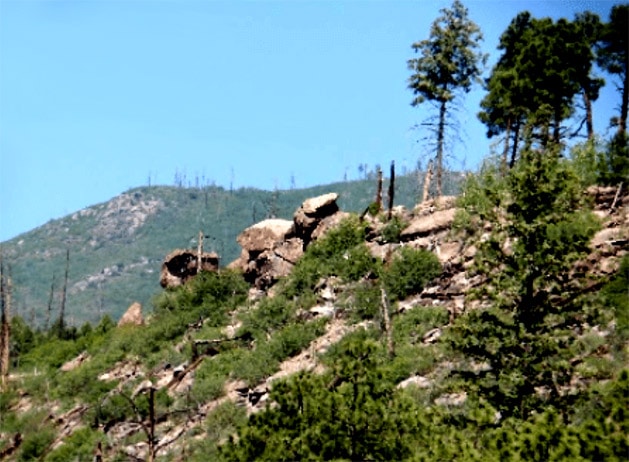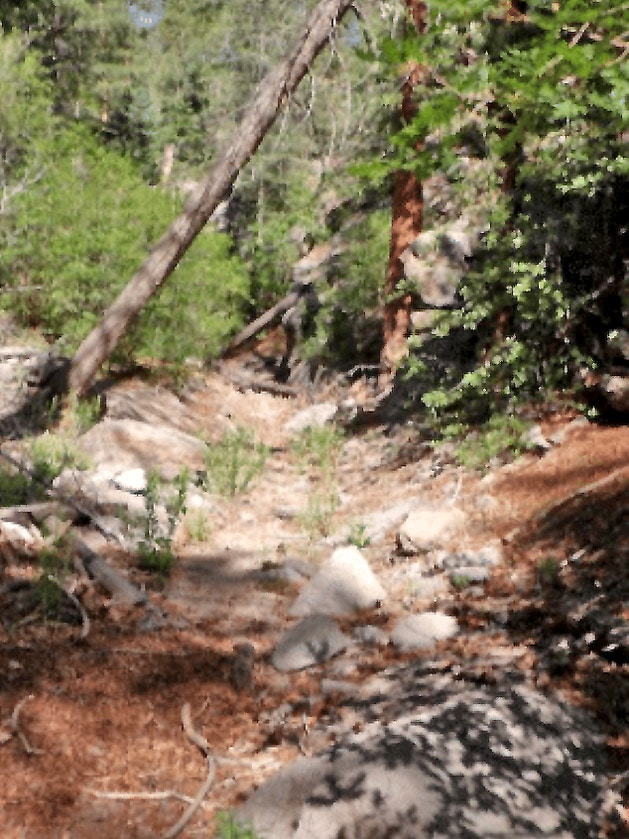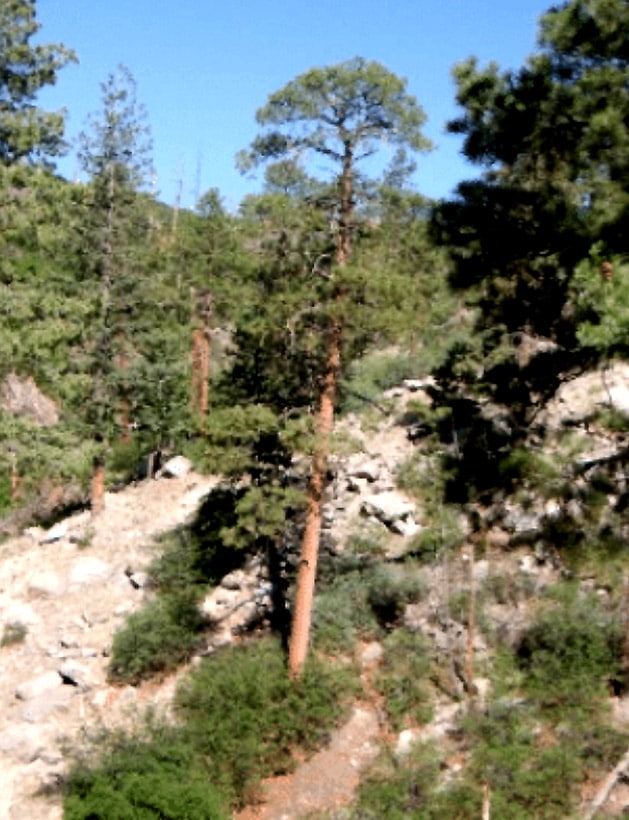 The slopes adjacent to upper Pueblo Canyon remain barren with boulders 21 years after the Cerro Grande Fire. A ponderosa tree has burnt branches lower on its trunk yet continues growing at its top. Photo by Robert Dryja
The slopes adjacent to upper Pueblo Canyon remain barren with boulders 21 years after the Cerro Grande Fire. A ponderosa tree has burnt branches lower on its trunk yet continues growing at its top. Photo by Robert Dryja
 By ROBERT DRYJA
By ROBERT DRYJA
Los Alamos
Pueblo Canyon is one of the largest canyons in the Los Alamos area. It is five miles long going upstream to where it encounters Diamond Drive. A rock dam exists at this point to provide the base of a roadway across the canyon.
Upper Pueblo Canyon then continues another three miles toward the mountain slopes of the Valles Caldera. Instead of a broad smooth bottom, it now has increasingly steeper walls that extend from the canyon top to its floor. The canyon floor now is only a few feet wide with a small stream bed.
The walls of lower Pueblo Canyon are 500 feet high and it is approximately half a mile wide when it approaches the Rio Grande. These dimensions change greatly in upper Pueblo Canyon. The walls are now only 100 feet high and the width is 300 feet. Although upper Pueblo Canyon is smaller for these dimensions, it is larger in terms of its drop of elevation. It starts at 8,500 feet of elevation and drops to 7,200 feet as it reaches the rock dam. This is a change of 1,300 feet over three miles. In comparison, lower Pueblo Canyon only drops 600 feet in elevation over the next five miles. Upper Pueblo Canyon starts on the slopes of the mountain while lower Pueblo Canyon passes through much more level mesas.
The smaller horizontal and vertical scales of the upper canyon actually make ecologic and geologic processes more apparent. The Cerro Grande Forest fire in 2000 burnt through this area. Plant life no longer held the rocky soil in place from rain or melting snow. Extensive erosion of the canyon and its adjacent slopes therefore occurred. Water flowing down the canyon carried silt, sand and smaller rocks to cover previously exposed larger rocks and boulders along the stream bed.
The stream bed has become a sandy walking trail when you hike downstream. Some trees were fortunate in that they did not grow close to one another or were in more open areas. These trees were not burnt completely since the fire was not so intense near to them. As a result, mature ponderosa trees can be seen from time to time adjacent to the canyon bottom. They have trunks up to three feet in diameter and stand seventy feet tall.
Flash floods may occur during the summer. The water flows over boulders that protrude upward from the stream bed or at bends in the stream. Large branches and parts of tree trunks being carried by the water but can become stuck at these rocky points. The height and width of these piles indicates that the flash flood water may be as much as four feet deep.
These piles will slowly disappear in coming decades. The wood will decompose and the water will carry away the bits and fragments. Given favorable climate conditions, the canyon may become deeply lined with shrubbery and trees. These will protect the slope from erosion. Without replacement due to ongoing erosion, the sand and small rocks now present may be eventually washed away. The stream bottom may become rocky again, much as it had been before the Cerro Grande Fire.
 Upper Pueblo Canyon walls now nearly connect. The canyon bottom is a stream bed. Photo by Robert Dryja
Upper Pueblo Canyon walls now nearly connect. The canyon bottom is a stream bed. Photo by Robert Dryja
 A mature ponderosa tree has survived the Cerro Grande Fire by having grown away from other trees. The creek bed is to the left side of the picture. Photo by Robert Dryja
A mature ponderosa tree has survived the Cerro Grande Fire by having grown away from other trees. The creek bed is to the left side of the picture. Photo by Robert Dryja
 Flash flooding has carried tree trunks and branches downstream. This pile is caught by a boulder protruding up from the stream bottom. Photo by Robert Dryja
Flash flooding has carried tree trunks and branches downstream. This pile is caught by a boulder protruding up from the stream bottom. Photo by Robert Dryja

